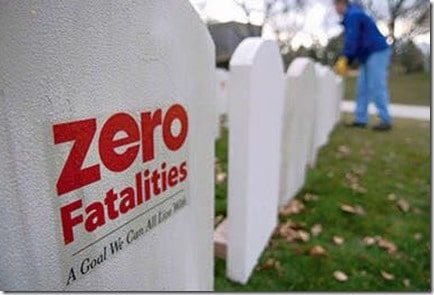Why Can’t Safety Be A Positive Thing?
 Last year I had to unsubscribe from quite a few safety newsletters. They were just chock full of disasters, deaths, fines and depressing stories. The latest one I received has inspirational headlines like: “Mandatory Drug Tests Start Soon” and “Bullying rife among surgeons” – aaarghhhh (see Isn’t Safety Supposed to Be a Positive Thing?). What’s the point of this negativity, scare tactics and fear peddling? Some have likened this to the fundamentalist preaching of “fire and brimstone”!
Last year I had to unsubscribe from quite a few safety newsletters. They were just chock full of disasters, deaths, fines and depressing stories. The latest one I received has inspirational headlines like: “Mandatory Drug Tests Start Soon” and “Bullying rife among surgeons” – aaarghhhh (see Isn’t Safety Supposed to Be a Positive Thing?). What’s the point of this negativity, scare tactics and fear peddling? Some have likened this to the fundamentalist preaching of “fire and brimstone”!
Imagine if you did this socially, how many friends would want to hang out with you?
Phil LaDuke wrote a great article about this recently: Do Scare Tactics Work? As did Dr Rob Long who says: “There are times when I think that the term Safety Professional should be swapped for the expression Anxiety and Fear Professional. The emphasis on strategy of ‘safety abnormality’ promotes short-term anxiety but does nothing to promote long-term change, learning and ownership” See Fear and Anxiety Professionals
There was one hopeful article I read…….At the recent SIA safety convention in Melbourne, Griffith University School of Humanities lecturer Dr Drew Rae, said: “safety as a profession is shaped by the stories we tell”, Safety Professionals need to stop focussing on “ghosts of disaster past”. He believes that sharing positive stories about safety is a lot more effective than developing procedures and spruiking scary stories. Unfortunately, the stories that safety people tell are a little more negative and “different” to the stories that most professionals tell and share.
Dr Rae is quoted as making the following excellent points during his speech:
- “If you’re a lawyer, you talk about great law cases. If you’re an engineer, you talk about giant monuments or innovations,”
- “The stories that other disciplines have all have heroes, and in safety, our stories don’t. Our stories have villains and they have victims.”
- “I think mostly we tell stories simply in order to motivate people through fear.”
- “Our big ideas in safety result from disasters like Deepwater Horizon, Chernobyl and Piper Alpha”
- “We use stories of the past to tell us what we should have done, and then we turn those into stories about the future: what we should do instead or bad things are going to happen,”
- “What I find most sinister is that we don’t just do this with the big accidents… We do it with very human stories as well”
- “We figuratively and sometimes quite literally drag out maimed and injured people as object moral lessons in the ways people should behave. We say, ‘This is what happens to you if you don’t follow the instructions.”
- “Essentially what we’re doing is we’re drawing upon the ghosts of disaster past and spectres of disaster future and we’re using it to justify the bureaucracy we want to put into the present.”


UPDATE – RESPONSE FROM DREW RAE:
Dave,
Thanks for your kind comments about my talk. I don’t think the article mentioned that I’m guilty myself of a lot of disaster storytelling. I do think being “disaster literate” is important for safety professionals, particularly when it comes to understanding the complexity and messy detail of what goes wrong. Overly-simple narratives lead to simplistic solutions. This is something I wrestle with, though. How much do we talk about bad outcomes because it is useful to do so, and how much do we do it just as a bad habit?


Do you have any thoughts? Please share them below